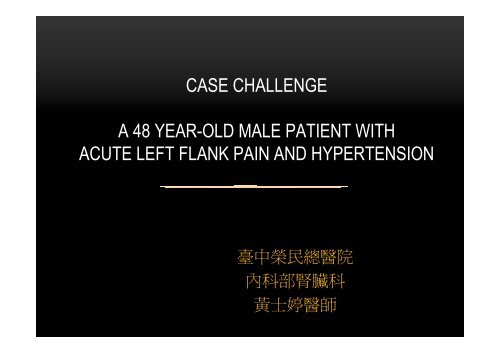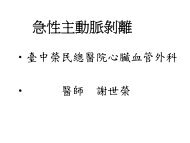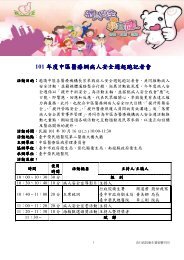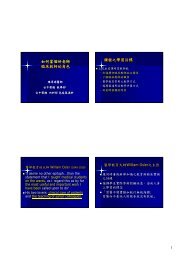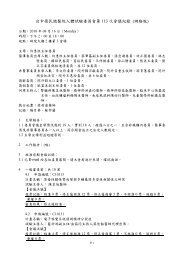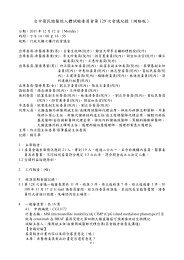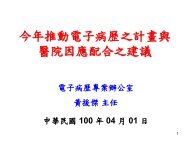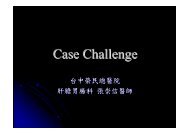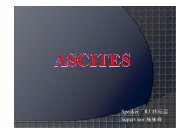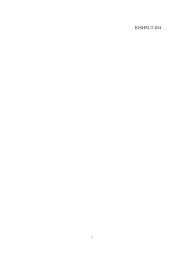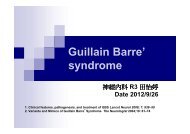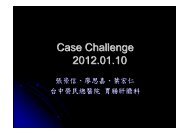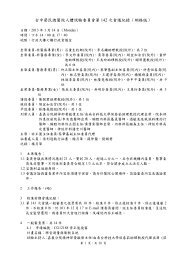A 48 y/o male patient with acute left flank pain and ... - å°ä¸æ¦®æ°ç¸½é«é¢
A 48 y/o male patient with acute left flank pain and ... - å°ä¸æ¦®æ°ç¸½é«é¢
A 48 y/o male patient with acute left flank pain and ... - å°ä¸æ¦®æ°ç¸½é«é¢
You also want an ePaper? Increase the reach of your titles
YUMPU automatically turns print PDFs into web optimized ePapers that Google loves.
CASE CHALLENGE<br />
A <strong>48</strong> YEAR-OLD MALE PATIENT WITH<br />
ACUTE LEFT FLANK PAIN AND HYPERTENSION<br />
臺 中 榮 民 總 醫 院<br />
內 科 部 腎 臟 科<br />
黃 士 婷 醫 師
病 史<br />
• 主 訴 : 急 性 左 下 腰 痛 達 2 天<br />
• 過 去 病 史 :<br />
左 側 腎 結 石 , 一 年 前 於 外 院 診 斷<br />
• 現 在 病 史 :<br />
<strong>acute</strong> onset of dullness <strong>pain</strong> over <strong>left</strong> <strong>flank</strong><br />
No radiation <strong>pain</strong>, no fever, no dysuria,<br />
no gross hematuria, no oliguria/anuria,<br />
no nausea/vomiting, no diarrhea,
日 期<br />
理 學 檢 查<br />
體 溫 (BT)<br />
脈 搏 (P)<br />
呼 吸 (R)<br />
血 壓 (BP)<br />
身 高 (BH)<br />
體 重 (BW)<br />
2012/01/<br />
11<br />
36.2C 78 次 /min 20 次<br />
/min<br />
182/100<br />
mmHg<br />
161cm<br />
74kg<br />
General appearance: A well-nourished person, <strong>with</strong> <strong>acute</strong> ill looking.<br />
Heart: Auscultation: Regular heart beats , No S3 , No S4 , No murmur<br />
Abdomen: Soft<br />
Back <strong>and</strong> spine: L’t <strong>flank</strong> knocking <strong>pain</strong>, no localized tender point<br />
Extremities: No pitting edema, normal peripheral pulse
Q1: WHAT IS YOUR IMPRESSION<br />
• 1. Renal or perinephric abscess<br />
• 2. Renal cell carcinoma<br />
• 3. Nephrolithiasis<br />
• 4. Mesenteric ischemia<br />
• 5. Renal infarction<br />
• 6. None at all
DIFFERENTIAL DIAGNOSIS OF FLANK PAIN<br />
Renal or perinephric abscess<br />
症 狀 : 發 燒 , 腰 痛 腹 痛 dysuria frequency<br />
Insidious in the elderly /autonomic neuropathy<br />
Lab: WBC,ESR,CRP<br />
Image: CT + contrast (extension)<br />
Nephrolithiasis<br />
症 狀 :<br />
1. 排 出 結 石 !<br />
2.<strong>pain</strong>: variable , waxes <strong>and</strong> wanes; by location;<br />
疼 痛 來 源 : passing stone ,ureteral spasm,<br />
阻 塞 ; 痛 持 續 約 20-60 分 鐘<br />
3. 血 尿 痛 或 無 痛 性 , 微 觀 或 巨 觀<br />
在 慢 性 下 背 痛 的 病 人 很 難 鑑 別 診 斷 , 需 影 像 檢 查<br />
Image: IVP,SONO, non-contrast CT<br />
Renal cell carcinoma<br />
classic triad of RCC :<br />
(<strong>flank</strong> <strong>pain</strong>, hematuria, <strong>and</strong> a<br />
palpable abdominal renal mass);<br />
Paraneoplastic symptoms<br />
Image: SONO>CT>MRI<br />
Mesenteric ischemia<br />
症 狀 : intestinal angina 飯 後 痛<br />
體 重 減 輕 噁 心 嘔 吐 腹 瀉<br />
危 險 因 子 : 老 人 , CVD<br />
診 斷 : Angiography, MRA
DIFFERENTIAL DIAGNOSIS OF FLANK PAIN<br />
Renal infarction<br />
症 狀 : 急 性 腰 痛 或 腹 痛 ; 少 見 : 發 燒 寡 尿<br />
急 性 高 血 壓 , 其 他 器 官 栓 塞<br />
Lab: ↑WBC, Cr, LDH X4 /GPT(-) U/R, U/C ,ECG<br />
Renal vein thrombosis<br />
症 狀 : loin <strong>pain</strong>, hematuria<br />
診 斷 : MRI<br />
Association: clotting disorder (protein C,s def.; NS)<br />
Aortic dissection<br />
誘 發 因 素 : 高 血 壓 , 之 前 有 aortic aneurysm, vasculitis, collagen disease<br />
Post CBG, AVR , Cocaine<br />
症 狀 :<br />
Abrupt, tearing <strong>pain</strong>, hypertension<br />
Variant of dissection : type A/B,<br />
intimal tear <strong>with</strong>out hematoma, intranural hematoma or penetrating atherosclerotic ulcer
“ RED FLAGS” FOR A POTENTIALLY SERIOUS<br />
UNDERLYING CAUSE FOR LOW BACK PAIN<br />
1. Recent significant trauma, or milder trauma age >50<br />
2. Unexplained weight loss<br />
3. Unexplained fever<br />
4. Immunosuppression<br />
5. History of cancer<br />
6. Intravenous drug use<br />
7. Osteoporosis, proloned use of glucocorticoids<br />
8. Age>70<br />
9. Focal neurologic deficit progressive or disabling symptoms<br />
10. Duration greater then 6 weeks<br />
Low back <strong>pain</strong>. American College of Radiology. ACR Appropriateness Criteria.
Sciatica<br />
Simple<br />
Complicated<br />
Radiculopathy<br />
Urgent<br />
CT or MRI<br />
Plain film<br />
ESR
LABORATORY DATA<br />
DATE WBC Hb Plt Neut Lym Mon<br />
1010110 21000 16.6 304K 87 8 3<br />
1010112 15100 14.9 293K 65.0 23.7 9.4<br />
Alb TP Bil,T AlkP AST ALT LDH<br />
1010110 4.5 7.4 0.5 78 49 64 399<br />
1010114 23 <strong>48</strong> 740<br />
1010116 281<br />
NA K Cl Ca BUN Cr<br />
1010110 140 3.9 107 8.7 16 1.3<br />
Urine routine:<br />
RBC: 0-2 /HP; WBC: 2-5/HP<br />
SP. GR.: 1.016; pH: 6.5; Protein: +; OB: -; Nitrate: -<br />
CRP: 0.29 mg/dL<br />
Lipase: 54 U/L<br />
D-Dimer: 0.58 mg/1 FEU
Q2: HOW TO APPROACH THIS PATIENT<br />
1. Renal isotope scan<br />
2. CT scan <strong>with</strong> contrast<br />
3. MRI<br />
4. Angiography
Q3. ADDITIONAL EVALUATION<br />
• 1. Consult CV for cardiac echo <strong>and</strong> Holter’s monitor<br />
• 2. Coagulation test<br />
• 3. Evaluation for procoagulant state
COAGULATION TEST<br />
• ACA IgG, IgM: (-)<br />
• AphL Ab: (-) Ab2GP 1 Ab: (-)<br />
• Protein C, S: (-)
DIAGNOSIS<br />
1. Acute renal infarction, L’t kidney<br />
2. Secondary hypertension , renin-mediated<br />
3. Suspect old MI, <strong>with</strong> LV mural thrombus<br />
4. Nephrolithiasis, R’t kidney
Renal Artery Embolism. J Gen Intern Med. 2008; 23(5):644–7
RISK FACTORS OF CLOT EMBOLI<br />
• Atrial fibrillation<br />
Incidence of renal thromboembolism in <strong>patient</strong>s <strong>with</strong> atrial fibrillation : 2%<br />
• Incident thromboembolism in the aorta <strong>and</strong> the renal, mesenteric, pelvic, <strong>and</strong> extremity<br />
arteries after discharge from the hospital <strong>with</strong> a diagnosis of atrial fibrillation.<br />
Arch Intern Med. 2001;161(2):272.<br />
• Diffuse atherosclerosis<br />
• Aortic dissection<br />
• Antiphospholipid syndrome
Renal Artery Embolism. J Gen Intern Med. 2008; 23(5):644–7
MAJOR SOURCE OF CLOT EMBOLISM<br />
1. <strong>left</strong> atrium or <strong>left</strong> atrial appendage in atrial fibrillation<br />
2. Left ventricular thrombus in <strong>patient</strong>s <strong>with</strong> a myocardial infarction<br />
3. Thromboembolic originating from complex plaque in the aorta<br />
• Other potential embolic sources include valvular vegetations in infective<br />
endocarditis<br />
• Rarely tumor <strong>and</strong> fat emboli<br />
• Paradoxical embolism through a patent foramen ovale
RENAL ARTERY THROMBOSIS<br />
• Preexisting atherosclerotic renovascular disease ,<br />
spontaneous or iatrogenic renal artery or aortic dissection, or as a complication following<br />
endovascular (aortic or renal) intervention<br />
• Other renal artery disease (secondary)<br />
• Anti-phospholipid syndrome<br />
• hypercoagulable states
More sensitive in Enhanced CT <strong>with</strong> submillimeter resolution <strong>and</strong><br />
multidetector CT technology (MDCT).<br />
Vascular abnormalities are rarely identified in <strong>acute</strong> renal infarct, but both CT <strong>and</strong><br />
MR angiography (CTA <strong>and</strong> MRA) are well-established methods of evaluating the<br />
renal vasculature.<br />
Consider allergy, renal function<br />
Renal Artery Embolism. J Gen Intern Med. 2008; 23(5):644–7
Oxford Textbook of Clinical Nephrology 10.6.5
ANTICOAGULATION<br />
• With other indication : atrial fibrillation, <strong>left</strong> ventricular thrombus,<br />
or a hypercoagulable state<br />
• Intravenous heparin followed by oral warfarin.<br />
• Goal INR: 2.0-3.0<br />
• Higher goal of 2.5-3.5 is reasonable if<br />
1. event occurred while on adequate warfarin therapy<br />
2. high risk (eg, rheumatic heart disease, prosthetic heart valves).
REPERFUSION<br />
• Systemic <strong>and</strong> local intraarterial thrombolysis<br />
1. Local infusion preferred<br />
2. Golden time (ischemic tolerance of kidney): 90-180 minutes<br />
3. Prolonged occlusion: consider collateral circulation<br />
4. Intraarterial thrombolysis in RAE: no consensus !!<br />
• Angioplasty<br />
• 合 理 來 說 , 單 側 RAE, 症 狀 發 生 後 數 小 時 內 , 且 兩 側 腎 功 能 佳 的<br />
病 患 較 有 益 處<br />
• Surgical revascularization<br />
Higher mortality rate <strong>and</strong> does not result in better outcomes
SUMMARY OF TREATMENT<br />
• Anticoagulation therapy<br />
• Indicated when warranted by the underlying disease<br />
AFib, <strong>left</strong> ventricular thrombus, or a hypercoagulable state<br />
• Reperfusion therapy (thrombolysis or angioplasty) should only be<br />
considered in <strong>patient</strong>s who :<br />
1. Do not yet have atrophy of the affected kidney on imaging studies.<br />
2. Do not have prolonged duration of occlusion<br />
3. Facts: Time to diagnosis following presentation is often >2 days<br />
RENAL OUTCOME AND PATIENT OUTCOME WITH<br />
RAE<br />
• Renal outcomes: favorable<br />
• 當 影 響 到 腎 功 能 需 要 透 析 時 , 死 亡 率 上 升<br />
• 常 見 死 因 :<br />
Recurrent embolic disease or CVD 而 非 腎 臟 相 關
Renal Artery Embolism. J Gen Intern Med. 2008; 23(5):644–7
TAKE HOME MESSAGE<br />
1. Renal infarction 少 見 , autopsy-proved incidence: 1.4%<br />
2. 發 生 原 因 : Thromboemboli (heart,aorta) > in-situ thrombosis<br />
3. 早 期 診 斷<br />
任 何 病 人 有 <strong>flank</strong> <strong>pain</strong>, 心 臟 病 史 (arrythmia, MI, VHD),<br />
LDH ↑↑ 都 要 懷 疑<br />
4. 當 診 斷 延 誤 時 , 治 療 以 heparin IV then coumadin 為 主


